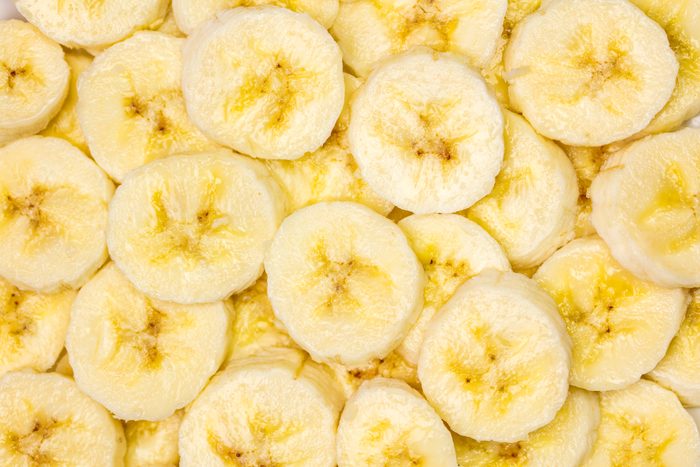Here’s How Much Sugar Is Really in a Banana, from a Nutrition Expert
Updated: Jul. 10, 2024

A certified nutrition professional unpacks sweet facts about bananas...and the answers have universal appeal.
With the rise of the “low-carb” diets in recent years, you may have heard the head-scratching claim that you should avoid bananas because “they have too much sugar” and aren’t great for you. It always seems like this suggestion comes from that keto-fanatic friend who’s ingesting their sixth or seventh piece of bacon as part of their daily breakfast. Not that bacon is necessarily bad for you—but when you think about it, any assertion that a natural, whole food should be avoided and substituted with a high-sodium piece of processed meat should be taken with a grain of salt (figuratively speaking, of course).
It’s no wonder something as sweetly simple as a banana has garnered a lot of confusion—especially for people who are watching their sugar intake, like diabetics who enjoy bananas.
So, here’s the skinny on bananas. Rest assured, America’s most popular fruit isn’t the monster its reputation has grown to be.
Get The Healthy @Reader’s Digest newsletter
Let’s talk about the sugar in bananas
According to the U.S. Department of Agriculture (the USDA), a medium-sized banana’s total carbohydrate content is about 27 grams. (That “medium-sized” banana is around seven to 8 inches in length, or 120 grams in weight with the peel on.)
Those 27 grams are further broken down into starch, fiber, and sugar. The total amount of sugar contained within the banana is 14.4 grams, which is made up primarily of three types of sugar that include sucrose, glucose, and fructose.
This total amount of sugar in the banana is just under half of what you would find in a can of regular soda—but, with a very important distinction. The starch and fiber in the banana are complex carbohydrates, whose presence will actually slow the body’s absorption of the sugars, thereby creating a slower and less drastic rise in blood sugar as compared to the sugary beverage. This is why bananas rank in the low range on the Glycemic Index scale on Harvard University’s public health blog. The Glycemic Index is a scale that is used to note how quickly a particular food can cause an increase in your overall blood glucose levels.
One additional note about the total sugar content is the change that occurs as bananas ripen. Bananas that are just entering into ripeness will have a higher starch content, which will gradually turn to sugar as the banana continues to ripen. For this reason, the ripest bananas will have the highest sugar content—not surprising, when you think about the sweeter flavor that comes out of that speckled peel.
Yes, You CAN Eat Carbs and Be Healthy—Here’s Why
A banana a day?
The higher carbohydrate and sugar content of the banana might suggest that this plant food fruit is a no-no, but doing so may cause them to miss out on a host of additional vitamins and minerals that can play an important role in any balanced diet. Meghen Bishop, a San Diego-based Certified Nutritionist, added that bananas are “a fibrous snack that is much healthier than eating white bread or chips.” With so much nutritional value, tossing bananas entirely aside may not be the wisest choice.
Which Antioxidant-Rich Fruits and Vegetables Should You Be Eating?
What about diabetes?
In terms of diabetes, there is a valid concern for any food that can cause a moderate spike to blood glucose levels, but a peer-reviewed pilot study published in 2014 demonstrated that “a banana a day is harmless both in diabetic and hypercholesterolemic (high cholesterol) volunteers and marginally beneficial to the latter.”
Bishop notes that diabetic consumption of a banana “isn’t restricted, but can depend on what the additional intake for the meal was.” Loading up on a huge bowl of mixed fruit might not be the healthiest idea for most anyone, especially if it’s not accompanied by some protein.
Of course, if you are a diabetic, consulting with your physician or a licensed or certified nutrition professional is always advisable.
Get The Healthy @Reader’s Digest newsletter and follow The Healthy on Facebook, Instagram, and Twitter. Keep reading:



















